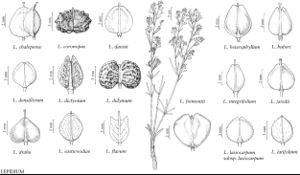Lepidium coronopus
Novon 14: 156. 2004.
Annuals; glabrous or puberulent. Stems often several from base, usually procumbent to decumbent, rarely ascending, branched distally, (0.3–) 0.6–2.5 (–3.5) dm. Basal leaves rosulate; petiole (1–) 2–5 (–5.8) cm; blade 1-pinnatisect or 2-pinnatisect, (3–) 4–10 (–15) cm, margins (of lobes) entire or dentate. Cauline leaves shortly petiolate; blade pinnatisect, base cuneate, not auriculate, margins (of lobes) entire or dentate, (similar to basal, smaller and less divided distally). Racemes (leaf-opposed), ± slightly elongated in fruit; rachis glabrous. Fruiting pedicels ascending, straight, (stout, terete), (0.7–) 1–2 (–2.4) × 0.4–0.5 mm, glabrous. Flowers: sepals (persistent), oblong, 1–1.5 × 0.5–0.6 mm; petals white, obovate to obovate-oblong, 1–2 × 0.4–0.6 mm, claw absent; stamens 6; filaments (median pairs) 0.7–1 mm, (glabrous); anthers 0.15–0.25 mm. Fruits (indehiscent), reniform to ovate-cordate, 2.3–3.4 × 3–4.4 mm, apically not winged, apical notch absent; valves thick, rugose-verrucose, with distinct ridges, prominently veined, glabrous; style 0.2–0.7 mm. Seeds ovate-oblong, (curved, not winged), 1.2–1.6 × 0.7–1 mm. 2n = 32.
Phenology: Flowering May–Aug.
Habitat: Waste grounds, abandoned fields, pastures, roadsides, disturbed sites
Distribution

Introduced; N.B., N.S., Ont., Que., Ala., Calif., La., Mo., N.J., Tenn., Europe, sw Asia, n Africa, also in South America (Chile), s Africa, Australia
Discussion
Selected References
None.
Lower Taxa
"elongated" is not a number."thick" is not a number."dm" is not declared as a valid unit of measurement for this property."dm" is not declared as a valid unit of measurement for this property.
